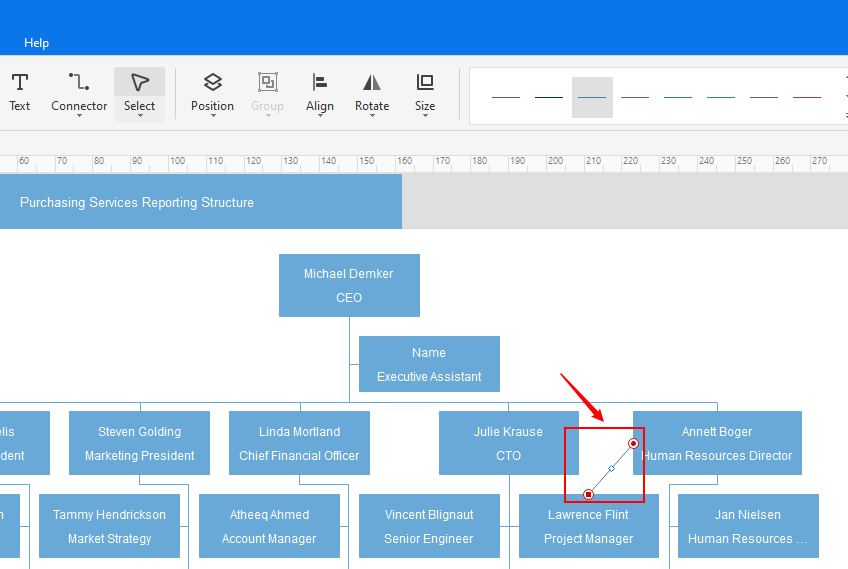Dotted line reporting is a term used to describe a functional relationship between two different departments or individuals within an organization. This type of reporting is used when there is a shared responsibility or a need for collaboration between two parties, but one of the parties does not have direct authority over the other.
In dotted line reporting, the reporting relationship is depicted by a dotted line rather than a solid one. This signifies that the relationship is not a direct or formal one, but rather an optional one. The dotted line serves to depict uncertainty and flexibility in the relationship between the two parties.
One of the most common examples of dotted line reporting is between project managers and team members. While project managers are responsible for overseeing the progress of a project, they often do not have direct authority over the team members working on the project. In this case, the team members would report to ther direct supervisor as their primary reporting relationship, but would also have a dotted line reporting relationship with the project manager.
Another example of dotted line reporting is when there is a shared responsibility between two different departments within an organization. For instance, the marketing department may have a dotted line reporting relationship with the sales department, as both departments work closely together to achieve the common goal of generating revenue for the company.
Dotted line reporting can be beneficial for organizations in a number of ways. It allows for flexibility and collaboration between different departments or individuals, while still maintaining clear reporting relationships. It also allows for the sharing of knowledge and expertise between different areas of the organization, which can lead to increased innovation and creativity.
However, dotted line reporting can also lead to confusion and lack of accountability if not managed properly. It is important for organizations to clearly define the roles and responsibilities of each party involved in the dotted line reporting relationship, to ensure that everyone is aware of their obligations and expectations.
Dotted line reporting is a useful tool for organizations that require collaboration and shared responsibility between different departments or individuals. While it can be beneficial, it is important to manage it effectively to avoid confusion and lack of accountability. By clearly defining roles and responsibilities, dotted line reporting can help organizations achieve their goals and foster innovation and creativity.
The Meaning of a Dotted Line
A dotted line is a type of line made up of a series of dots or dashes that are evenly spaced apart. It is commonly used in various forms and documents to indicate a specific area where a signature or initials are required. This line serves as a guide for individuals to sign or initial in the appropriate area, and it is often referred to as the “signature line” or “initial line”. When someone is asked to “sign on the dotted line”, it means that they are being asked to agree to the terms or conditions outlined in the document by providing ther signature in the designated area indicated by the dotted line.

The Meaning of a Dotted Line in a Model
The dotted line in a model is typically used to represent optional relationships between entities. This means that an entity does not necessarily need to participate in the relationship, and can exist independently of it. For example, in a customer and order relationship, where one customer can have multiple orders, the dotted line would indicate that a customer does not need to have any orders placed to still exist in the system. This allows for greater flexibility in the design of the model and provides a clearer understanding of the relationships between entities. It is important to note that the use of dotted lines may vary depending on the specific modeling notation or methodology bing used.
The Definition of a Functional Reporting Line
A functional reporting line is a type of reporting relationship that connects positions or organizational units at different management levels based on the specialized nature of the function for which a mutual responsibility is shared. In this type of reporting line, individuals or units report to managers who are responsible for overseeing a specific function, such as finance, marketing, or human resources.
For example, in a company with a functional reporting line for finance, all employees who work in the finance department would report to a finance manager who is responsible for overseeing all financial activities in the company. This manager would be accountable for the performance of the finance department and would provde guidance and direction to employees working in that department.
Functional reporting lines are commonly used in organizations that have a complex structure and require specialized skills and expertise to perform specific functions. This type of reporting line helps to ensure that the functions are performed efficiently and effectively, and that communication is streamlined between the different levels of management. functional reporting lines are an important tool for ensuring that an organization’s functions are aligned with its goals and objectives, and that its resources are used effectively.
Conclusion
Dotted line reporting is a common practice in organizations that establishes a functional relationship between positions or units at different management levels. It is represented by a line of dots or dashes and is oten used to depict uncertainty or optional participation in a relationship. Dotted line reporting is an effective way to share responsibility for a specialized function while maintaining a clear reporting structure. It can facilitate collaboration and communication between teams and departments, leading to increased efficiency and productivity. However, it is important to ensure that roles and responsibilities are clearly defined to avoid confusion and potential conflicts. dotted line reporting is a valuable tool for organizations to enhance their structure and improve their performance.
